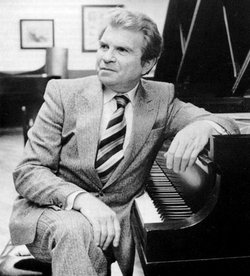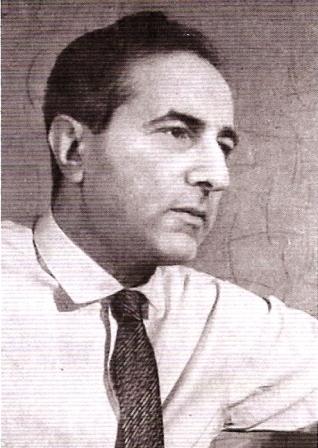October 15, 2018.Gilels and Flier.Last week we were celebrating the life of Monserrat Caballé, and missed the birthday of one of her stage partners, the incomparable Luciano Pavarotti, who was born on October 12th of 1935 in Modena.We mentioned a recording he made in 1984 with Joan Sutherland and Caballé.Here’s the trio from Act I of Bellini’s Norma: Pavarotti is Pollione, Sutherland, who was 58 at the time of the recording, is Norma and Caballé – Adalgisa.
Two great Soviet pianists were also born this week in what was then the Russian Empire: Emil Gilels on October 19th of 1916 and Yakov Flier, on October 21st of 1912.Gilels was born in Odessa (now in Ukraine), Flier – in a small town not far from Moscow.Both were Jewish; with few exception (the rich merchants, the highly educated) Jews were not allowed to live outside of the Pale of Settlement, in the western part of the Empire.How Flier’s parents, a poor family of a watchmaker, managed to live so close to Moscow, isn’t clear.
Gilels, a child prodigy, started his piano studies at the age of five and a half.By the age of 12 he had acquired a considerable repertoire, gave his first recital and was accepted at the Odessa Conservatory.In 1933, at the age of 16, he won the First All-Union Competition of Musicians-Performers.That made him famous and allowed him to perform across the country.In 1935-38 he studied with Heinrich Neuhaus, the famed Moscow Conservatory teacher.By that time Yakov Flier was his main competitor: in 1936 Gilels lost to Flier at the International piano competition in Vienna, where Flier took the first prize, while Gilels took the second, but two years later he had his revenge at the Ysaÿe International Festival in Brussels (after the war this competition would be renamed the Queen Elizabeth): Gilels won and Flier took third place (Moura Lympany came in second).The Second World War put the breakes on Gilels’s international career: he was scheduled to play in the US in 1939 but the tour was canceled.After the war, the great Sviatoslav Richter became his main competitor and eventually overtook him in the Soviet hierarchy, which always needed one person at the top.This had little to do with Gilels’s real achievements: in 1955 he made his US debut, which was highly successful; he played in a trio with Leonid Kogan and Mstislav Rostropovich; he was invited to every major concert hall of Europe.Gilels had a heart attack in 1981 from which he never completely recovered.He died on October 14th of 1985.
Yakov Flier was somewhat of a late starter.He studied with the famous Konstantin Igumnov but wasn’t a star at the Conservatory.He graduated in 1934 and only then did his career take off.After several triumphs at international competitions he became as famous as Gilels.His style, though, was very different, more romantic, sometimes verging on exalted, and so was his repertoire, Romantic at the core – Liszt and Chopin were his favorites, together with Rachmaninov (he also played compositions by contemporary Soviet composers, like Prokofiev, Shostakovich and Kabalevsky).Tragically, his career was cut short: around 1945 he developed a problem in his right hand, which progressed; by 1949 he stopped playing recitals.Flier resumed his solo career in 1959-1960; though not as much a virtuoso as before, his playing had by then acquired the depth which he sometimes lacked in his earlier years.Here’s a live recording of Schumann’s Symphonic Etudes Op. 13 made in 1960.
A year ago, we wrote two entries about an old photo depicting a group of six young Soviet musicians; Gilels and Flier were among them.You can read them here and here.More on Gilels is here.
Gilels and Flier, 2018
October 15, 2018. Gilels and Flier. Last week we were celebrating the life of Monserrat Caballé, and missed the birthday of one of her stage partners, the incomparable Luciano Pavarotti, who was born on October 12th of 1935 in Modena. We mentioned a recording he made in 1984 with Joan Sutherland and Caballé. Here’s the trio from Act I of Bellini’s Norma: Pavarotti is Pollione, Sutherland, who was 58 at the time of the recording, is Norma and Caballé – Adalgisa.
Two great Soviet pianists were also born this week in what was then the Russian Empire: Emil Gilels on October 19th of 1916 and Yakov Flier, on October 21st of 1912. Gilels was born in Odessa (now in Ukraine), Flier – in a small town not far from Moscow. Both were Jewish; with few exception (the rich merchants, the highly educated) Jews were not allowed to live outside of the Pale of Settlement, in the western part of the Empire. How Flier’s parents, a poor family of a watchmaker, managed to live so close to Moscow, isn’t clear.
Gilels, a child prodigy, started his piano studies at the age of five and a half. By the age of 12 he had acquired a considerable repertoire, gave his first recital and was accepted at the Odessa Conservatory. In 1933, at the age of 16, he won the First All-Union Competition of Musicians-Performers. That made him famous and allowed him to perform across the country. In 1935-38 he studied with Heinrich Neuhaus, the famed Moscow Conservatory teacher. By that time Yakov Flier was his main competitor: in 1936 Gilels lost to Flier at the International piano competition in Vienna, where Flier took the first prize, while Gilels took the second, but two years later he had his revenge at the Ysaÿe International Festival in Brussels (after the war this competition would be renamed the Queen Elizabeth): Gilels won and Flier took third place (Moura Lympany came in second). The Second World War put the breakes on Gilels’s international career: he was scheduled to play in the US in 1939 but the tour was canceled. After the war, the great Sviatoslav Richter became his main competitor and eventually overtook him in the Soviet hierarchy, which always needed one person at the top. This had little to do with Gilels’s real achievements: in 1955 he made his US debut, which was highly successful; he played in a trio with Leonid Kogan and Mstislav Rostropovich; he was invited to every major concert hall of Europe. Gilels had a heart attack in 1981 from which he never completely recovered. He died on October 14th of 1985.
Conservatory. In 1933, at the age of 16, he won the First All-Union Competition of Musicians-Performers. That made him famous and allowed him to perform across the country. In 1935-38 he studied with Heinrich Neuhaus, the famed Moscow Conservatory teacher. By that time Yakov Flier was his main competitor: in 1936 Gilels lost to Flier at the International piano competition in Vienna, where Flier took the first prize, while Gilels took the second, but two years later he had his revenge at the Ysaÿe International Festival in Brussels (after the war this competition would be renamed the Queen Elizabeth): Gilels won and Flier took third place (Moura Lympany came in second). The Second World War put the breakes on Gilels’s international career: he was scheduled to play in the US in 1939 but the tour was canceled. After the war, the great Sviatoslav Richter became his main competitor and eventually overtook him in the Soviet hierarchy, which always needed one person at the top. This had little to do with Gilels’s real achievements: in 1955 he made his US debut, which was highly successful; he played in a trio with Leonid Kogan and Mstislav Rostropovich; he was invited to every major concert hall of Europe. Gilels had a heart attack in 1981 from which he never completely recovered. He died on October 14th of 1985.
Yakov Flier was somewhat of a late starter. He studied with the famous Konstantin Igumnov but wasn’t a star at the Conservatory. He graduated in 1934 and only then did his career take off. After several triumphs at international competitions he became as famous as Gilels. His style, though, was very different, more romantic, sometimes verging on exalted, and so was his repertoire, Romantic at the core – Liszt and Chopin were his favorites, together with Rachmaninov (he also played compositions by contemporary Soviet composers, like Prokofiev, Shostakovich and Kabalevsky). Tragically, his career was cut short: around 1945 he developed a problem in his right hand, which progressed; by 1949 he stopped playing recitals. Flier resumed his solo career in 1959-1960; though not as much a virtuoso as before, his playing had by then acquired the depth which he sometimes lacked in his earlier years. Here’s a live recording of Schumann’s Symphonic Etudes Op. 13 made in 1960.
After several triumphs at international competitions he became as famous as Gilels. His style, though, was very different, more romantic, sometimes verging on exalted, and so was his repertoire, Romantic at the core – Liszt and Chopin were his favorites, together with Rachmaninov (he also played compositions by contemporary Soviet composers, like Prokofiev, Shostakovich and Kabalevsky). Tragically, his career was cut short: around 1945 he developed a problem in his right hand, which progressed; by 1949 he stopped playing recitals. Flier resumed his solo career in 1959-1960; though not as much a virtuoso as before, his playing had by then acquired the depth which he sometimes lacked in his earlier years. Here’s a live recording of Schumann’s Symphonic Etudes Op. 13 made in 1960.
A year ago, we wrote two entries about an old photo depicting a group of six young Soviet musicians; Gilels and Flier were among them. You can read them here and here. More on Gilels is here.